Business Principles: Demand, Supply, Elasticity, and Wage Inequality
VerifiedAdded on 2023/04/07
|6
|1103
|457
Homework Assignment
AI Summary
This assignment covers key concepts in business principles, including demand curves for normal goods, the impact of income on demand, and the supply challenges of organic food. It further examines the role of technology in wage inequality and calculates price elasticity of demand using the midpoint formula. The analysis provides insights into market dynamics, consumer behavior, and the economic forces shaping wage disparities in the modern economy. This assignment solution is available on Desklib, a platform offering a range of study tools and resources for students.
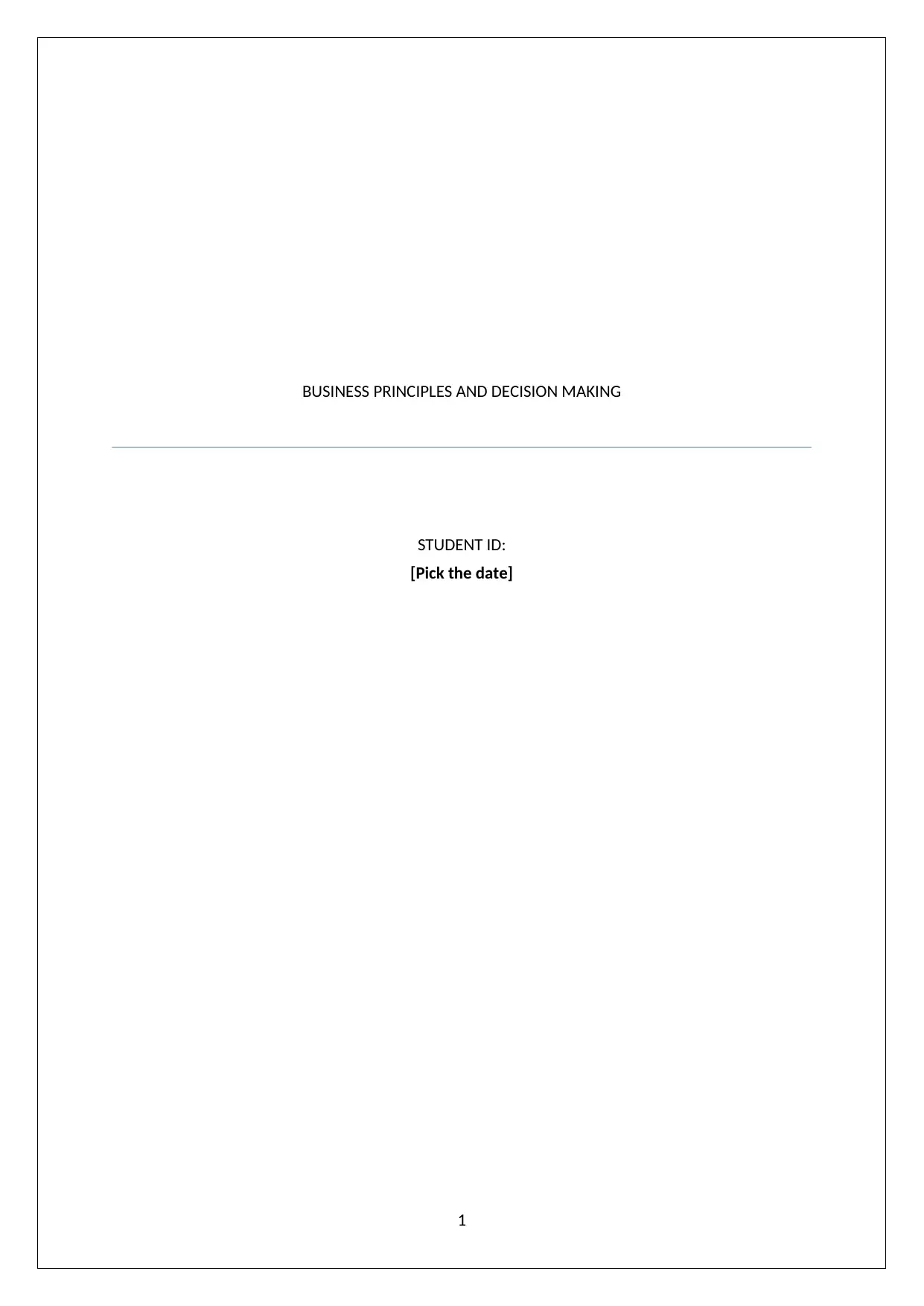
BUSINESS PRINCIPLES AND DECISION MAKING
STUDENT ID:
[Pick the date]
1
STUDENT ID:
[Pick the date]
1
Paraphrase This Document
Need a fresh take? Get an instant paraphrase of this document with our AI Paraphraser
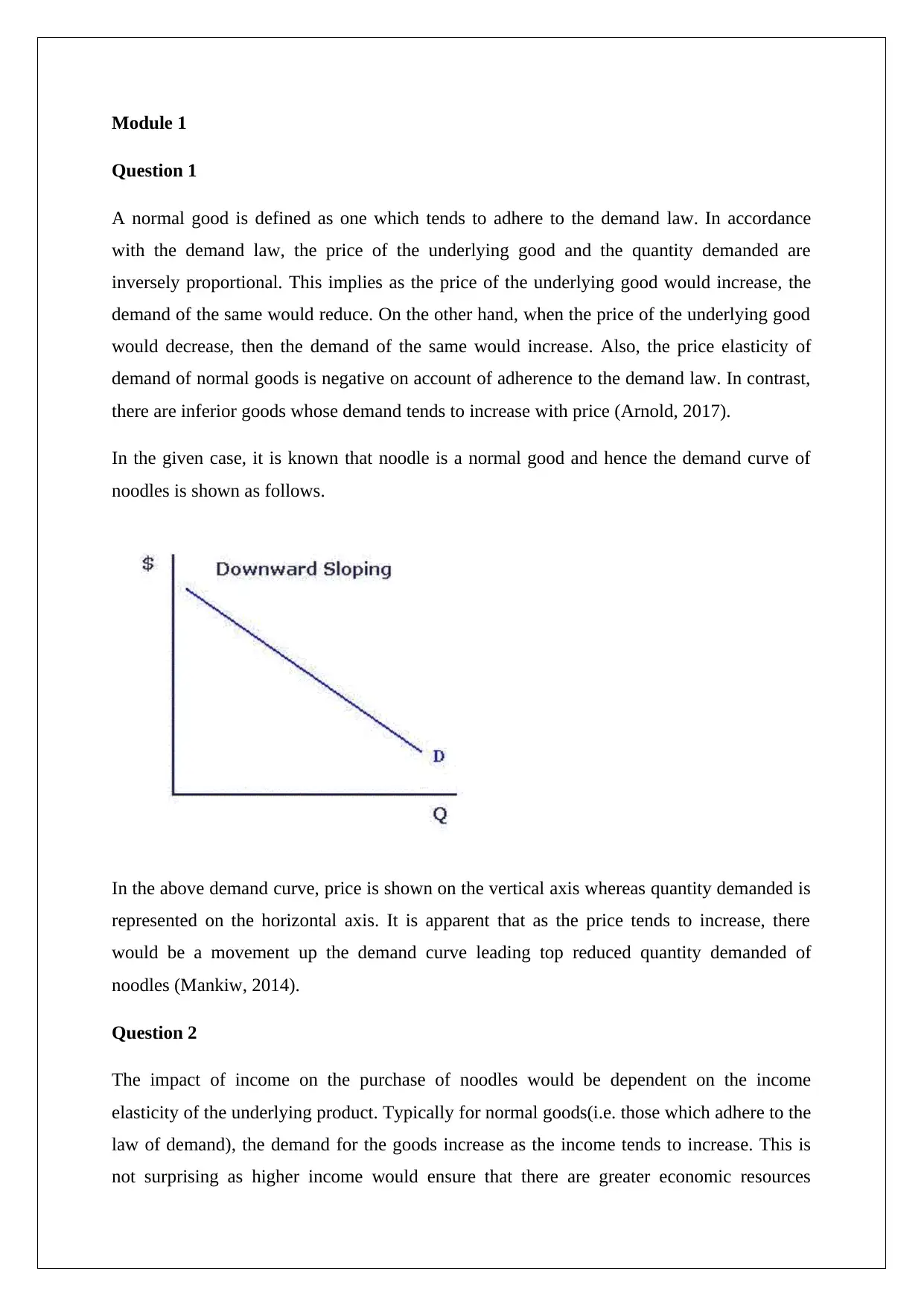
Module 1
Question 1
A normal good is defined as one which tends to adhere to the demand law. In accordance
with the demand law, the price of the underlying good and the quantity demanded are
inversely proportional. This implies as the price of the underlying good would increase, the
demand of the same would reduce. On the other hand, when the price of the underlying good
would decrease, then the demand of the same would increase. Also, the price elasticity of
demand of normal goods is negative on account of adherence to the demand law. In contrast,
there are inferior goods whose demand tends to increase with price (Arnold, 2017).
In the given case, it is known that noodle is a normal good and hence the demand curve of
noodles is shown as follows.
In the above demand curve, price is shown on the vertical axis whereas quantity demanded is
represented on the horizontal axis. It is apparent that as the price tends to increase, there
would be a movement up the demand curve leading top reduced quantity demanded of
noodles (Mankiw, 2014).
Question 2
The impact of income on the purchase of noodles would be dependent on the income
elasticity of the underlying product. Typically for normal goods(i.e. those which adhere to the
law of demand), the demand for the goods increase as the income tends to increase. This is
not surprising as higher income would ensure that there are greater economic resources
Question 1
A normal good is defined as one which tends to adhere to the demand law. In accordance
with the demand law, the price of the underlying good and the quantity demanded are
inversely proportional. This implies as the price of the underlying good would increase, the
demand of the same would reduce. On the other hand, when the price of the underlying good
would decrease, then the demand of the same would increase. Also, the price elasticity of
demand of normal goods is negative on account of adherence to the demand law. In contrast,
there are inferior goods whose demand tends to increase with price (Arnold, 2017).
In the given case, it is known that noodle is a normal good and hence the demand curve of
noodles is shown as follows.
In the above demand curve, price is shown on the vertical axis whereas quantity demanded is
represented on the horizontal axis. It is apparent that as the price tends to increase, there
would be a movement up the demand curve leading top reduced quantity demanded of
noodles (Mankiw, 2014).
Question 2
The impact of income on the purchase of noodles would be dependent on the income
elasticity of the underlying product. Typically for normal goods(i.e. those which adhere to the
law of demand), the demand for the goods increase as the income tends to increase. This is
not surprising as higher income would ensure that there are greater economic resources
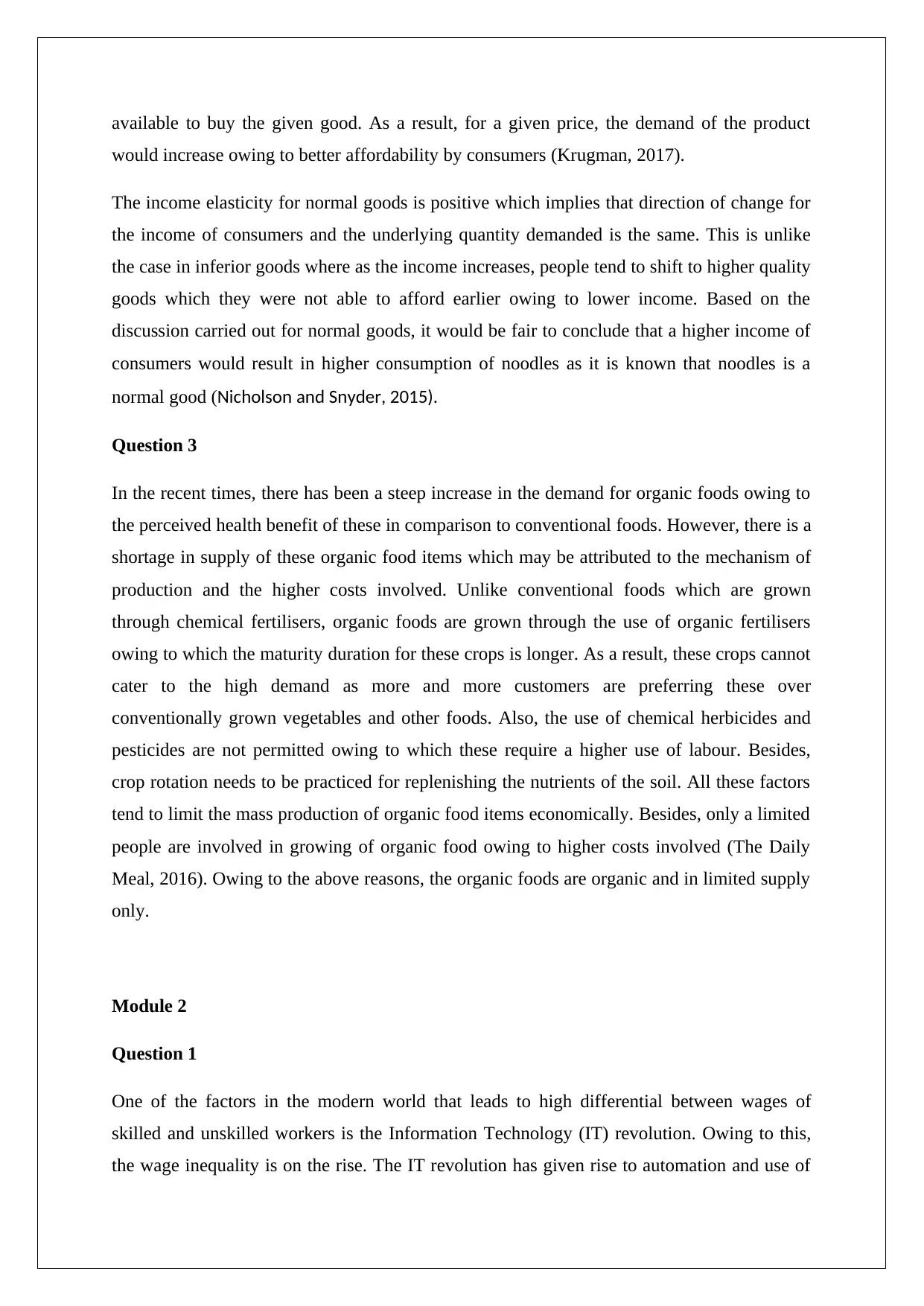
available to buy the given good. As a result, for a given price, the demand of the product
would increase owing to better affordability by consumers (Krugman, 2017).
The income elasticity for normal goods is positive which implies that direction of change for
the income of consumers and the underlying quantity demanded is the same. This is unlike
the case in inferior goods where as the income increases, people tend to shift to higher quality
goods which they were not able to afford earlier owing to lower income. Based on the
discussion carried out for normal goods, it would be fair to conclude that a higher income of
consumers would result in higher consumption of noodles as it is known that noodles is a
normal good (Nicholson and Snyder, 2015).
Question 3
In the recent times, there has been a steep increase in the demand for organic foods owing to
the perceived health benefit of these in comparison to conventional foods. However, there is a
shortage in supply of these organic food items which may be attributed to the mechanism of
production and the higher costs involved. Unlike conventional foods which are grown
through chemical fertilisers, organic foods are grown through the use of organic fertilisers
owing to which the maturity duration for these crops is longer. As a result, these crops cannot
cater to the high demand as more and more customers are preferring these over
conventionally grown vegetables and other foods. Also, the use of chemical herbicides and
pesticides are not permitted owing to which these require a higher use of labour. Besides,
crop rotation needs to be practiced for replenishing the nutrients of the soil. All these factors
tend to limit the mass production of organic food items economically. Besides, only a limited
people are involved in growing of organic food owing to higher costs involved (The Daily
Meal, 2016). Owing to the above reasons, the organic foods are organic and in limited supply
only.
Module 2
Question 1
One of the factors in the modern world that leads to high differential between wages of
skilled and unskilled workers is the Information Technology (IT) revolution. Owing to this,
the wage inequality is on the rise. The IT revolution has given rise to automation and use of
would increase owing to better affordability by consumers (Krugman, 2017).
The income elasticity for normal goods is positive which implies that direction of change for
the income of consumers and the underlying quantity demanded is the same. This is unlike
the case in inferior goods where as the income increases, people tend to shift to higher quality
goods which they were not able to afford earlier owing to lower income. Based on the
discussion carried out for normal goods, it would be fair to conclude that a higher income of
consumers would result in higher consumption of noodles as it is known that noodles is a
normal good (Nicholson and Snyder, 2015).
Question 3
In the recent times, there has been a steep increase in the demand for organic foods owing to
the perceived health benefit of these in comparison to conventional foods. However, there is a
shortage in supply of these organic food items which may be attributed to the mechanism of
production and the higher costs involved. Unlike conventional foods which are grown
through chemical fertilisers, organic foods are grown through the use of organic fertilisers
owing to which the maturity duration for these crops is longer. As a result, these crops cannot
cater to the high demand as more and more customers are preferring these over
conventionally grown vegetables and other foods. Also, the use of chemical herbicides and
pesticides are not permitted owing to which these require a higher use of labour. Besides,
crop rotation needs to be practiced for replenishing the nutrients of the soil. All these factors
tend to limit the mass production of organic food items economically. Besides, only a limited
people are involved in growing of organic food owing to higher costs involved (The Daily
Meal, 2016). Owing to the above reasons, the organic foods are organic and in limited supply
only.
Module 2
Question 1
One of the factors in the modern world that leads to high differential between wages of
skilled and unskilled workers is the Information Technology (IT) revolution. Owing to this,
the wage inequality is on the rise. The IT revolution has given rise to automation and use of
⊘ This is a preview!⊘
Do you want full access?
Subscribe today to unlock all pages.

Trusted by 1+ million students worldwide
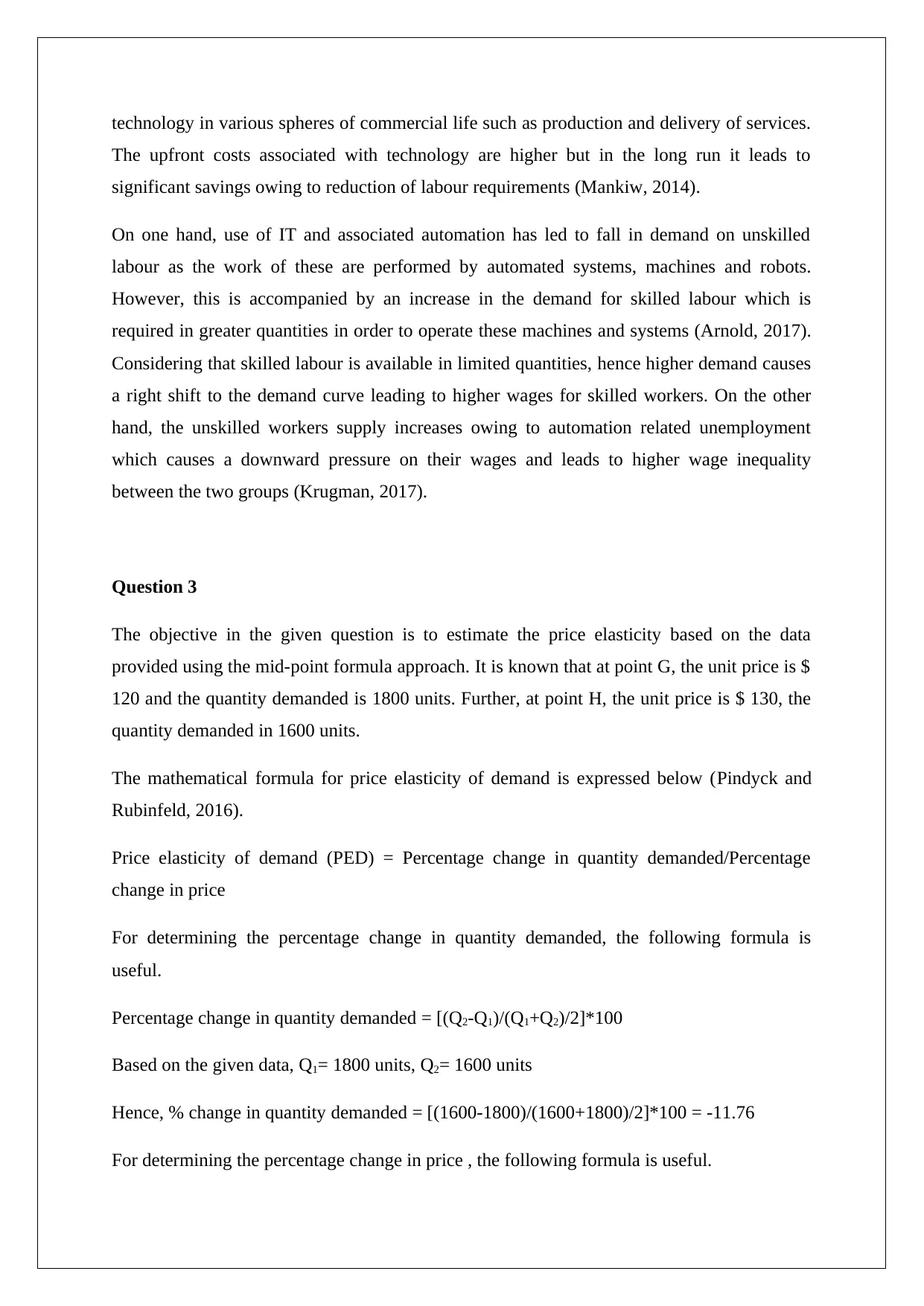
technology in various spheres of commercial life such as production and delivery of services.
The upfront costs associated with technology are higher but in the long run it leads to
significant savings owing to reduction of labour requirements (Mankiw, 2014).
On one hand, use of IT and associated automation has led to fall in demand on unskilled
labour as the work of these are performed by automated systems, machines and robots.
However, this is accompanied by an increase in the demand for skilled labour which is
required in greater quantities in order to operate these machines and systems (Arnold, 2017).
Considering that skilled labour is available in limited quantities, hence higher demand causes
a right shift to the demand curve leading to higher wages for skilled workers. On the other
hand, the unskilled workers supply increases owing to automation related unemployment
which causes a downward pressure on their wages and leads to higher wage inequality
between the two groups (Krugman, 2017).
Question 3
The objective in the given question is to estimate the price elasticity based on the data
provided using the mid-point formula approach. It is known that at point G, the unit price is $
120 and the quantity demanded is 1800 units. Further, at point H, the unit price is $ 130, the
quantity demanded in 1600 units.
The mathematical formula for price elasticity of demand is expressed below (Pindyck and
Rubinfeld, 2016).
Price elasticity of demand (PED) = Percentage change in quantity demanded/Percentage
change in price
For determining the percentage change in quantity demanded, the following formula is
useful.
Percentage change in quantity demanded = [(Q2-Q1)/(Q1+Q2)/2]*100
Based on the given data, Q1= 1800 units, Q2= 1600 units
Hence, % change in quantity demanded = [(1600-1800)/(1600+1800)/2]*100 = -11.76
For determining the percentage change in price , the following formula is useful.
The upfront costs associated with technology are higher but in the long run it leads to
significant savings owing to reduction of labour requirements (Mankiw, 2014).
On one hand, use of IT and associated automation has led to fall in demand on unskilled
labour as the work of these are performed by automated systems, machines and robots.
However, this is accompanied by an increase in the demand for skilled labour which is
required in greater quantities in order to operate these machines and systems (Arnold, 2017).
Considering that skilled labour is available in limited quantities, hence higher demand causes
a right shift to the demand curve leading to higher wages for skilled workers. On the other
hand, the unskilled workers supply increases owing to automation related unemployment
which causes a downward pressure on their wages and leads to higher wage inequality
between the two groups (Krugman, 2017).
Question 3
The objective in the given question is to estimate the price elasticity based on the data
provided using the mid-point formula approach. It is known that at point G, the unit price is $
120 and the quantity demanded is 1800 units. Further, at point H, the unit price is $ 130, the
quantity demanded in 1600 units.
The mathematical formula for price elasticity of demand is expressed below (Pindyck and
Rubinfeld, 2016).
Price elasticity of demand (PED) = Percentage change in quantity demanded/Percentage
change in price
For determining the percentage change in quantity demanded, the following formula is
useful.
Percentage change in quantity demanded = [(Q2-Q1)/(Q1+Q2)/2]*100
Based on the given data, Q1= 1800 units, Q2= 1600 units
Hence, % change in quantity demanded = [(1600-1800)/(1600+1800)/2]*100 = -11.76
For determining the percentage change in price , the following formula is useful.
Paraphrase This Document
Need a fresh take? Get an instant paraphrase of this document with our AI Paraphraser
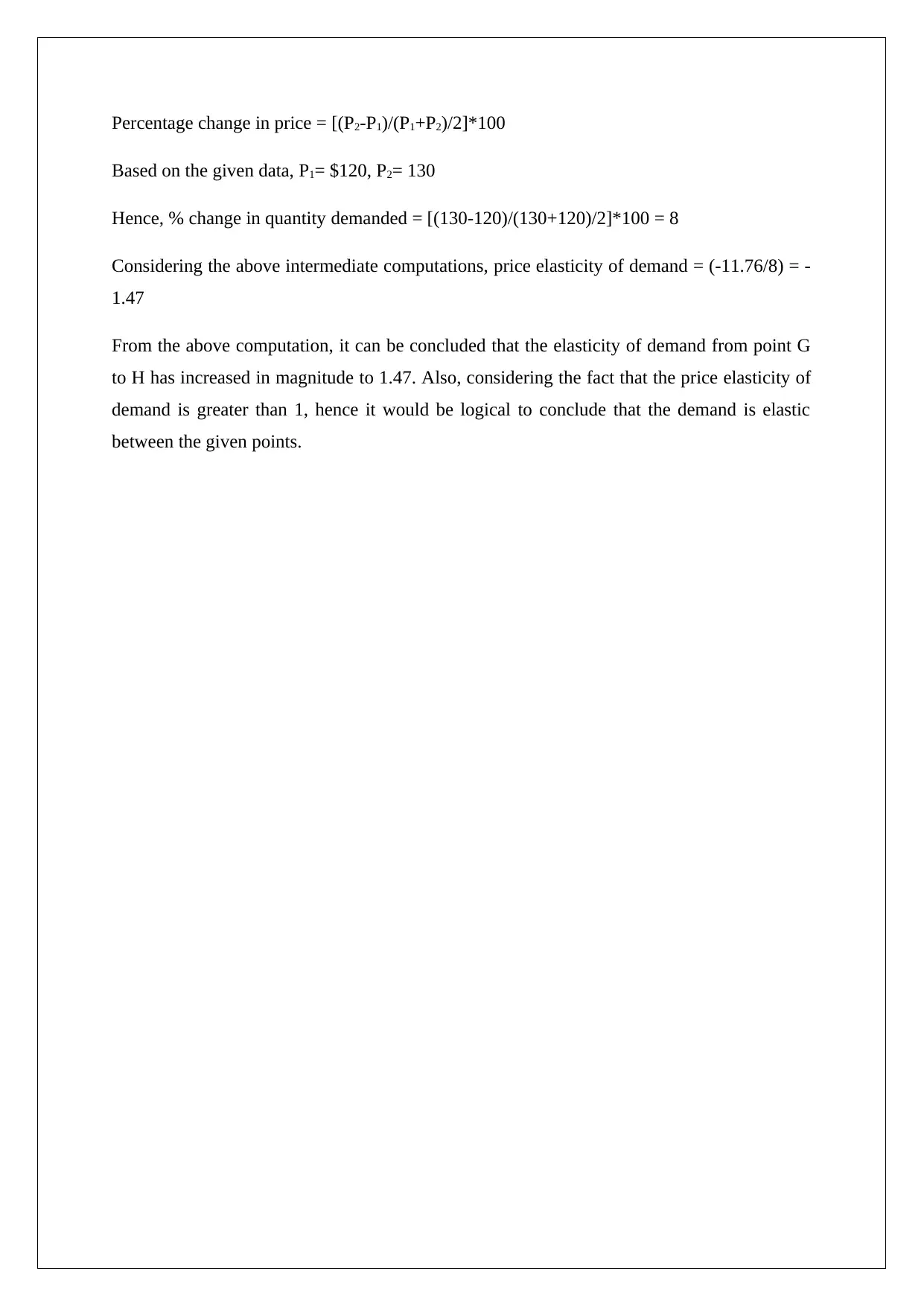
Percentage change in price = [(P2-P1)/(P1+P2)/2]*100
Based on the given data, P1= $120, P2= 130
Hence, % change in quantity demanded = [(130-120)/(130+120)/2]*100 = 8
Considering the above intermediate computations, price elasticity of demand = (-11.76/8) = -
1.47
From the above computation, it can be concluded that the elasticity of demand from point G
to H has increased in magnitude to 1.47. Also, considering the fact that the price elasticity of
demand is greater than 1, hence it would be logical to conclude that the demand is elastic
between the given points.
Based on the given data, P1= $120, P2= 130
Hence, % change in quantity demanded = [(130-120)/(130+120)/2]*100 = 8
Considering the above intermediate computations, price elasticity of demand = (-11.76/8) = -
1.47
From the above computation, it can be concluded that the elasticity of demand from point G
to H has increased in magnitude to 1.47. Also, considering the fact that the price elasticity of
demand is greater than 1, hence it would be logical to conclude that the demand is elastic
between the given points.
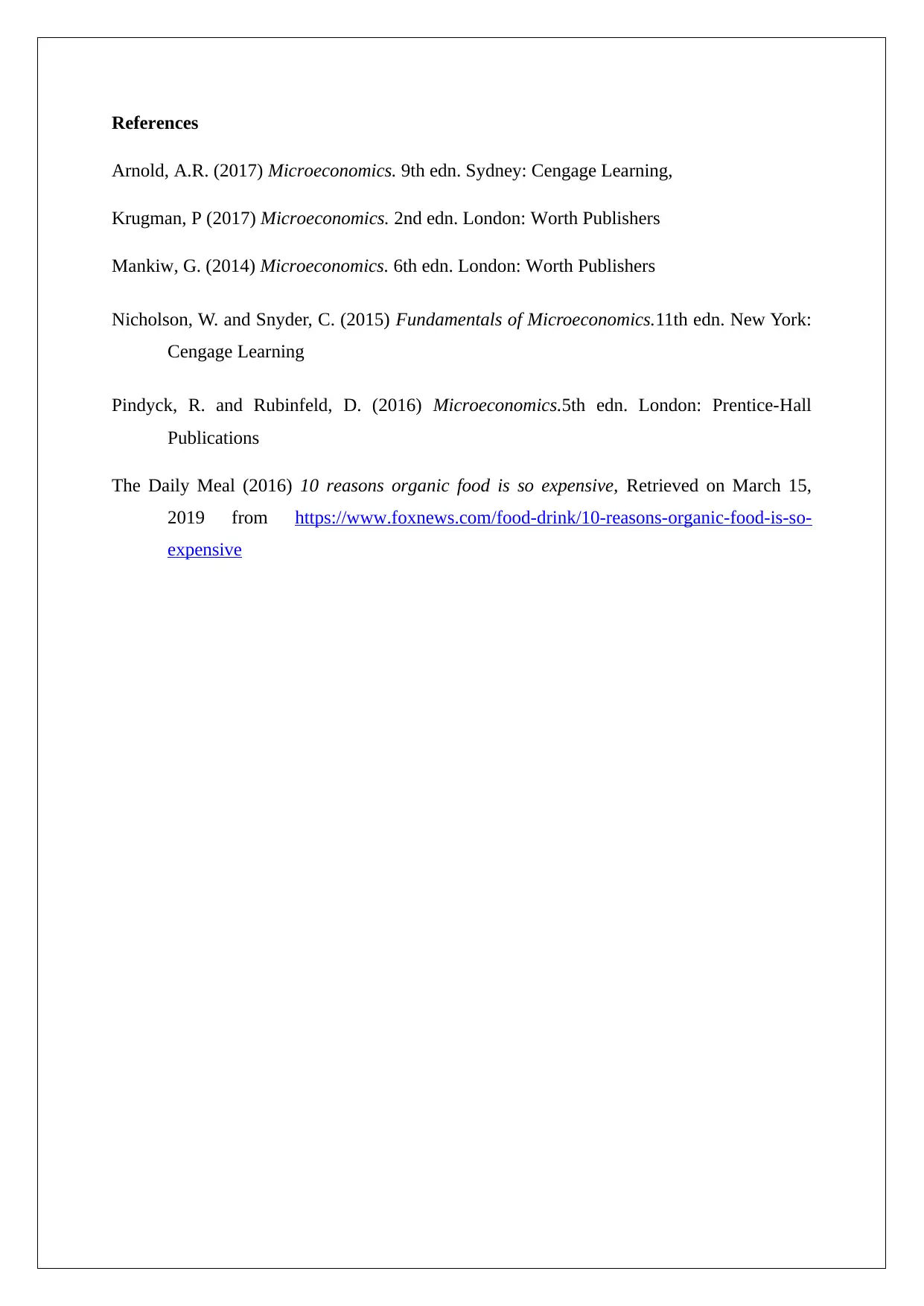
References
Arnold, A.R. (2017) Microeconomics. 9th edn. Sydney: Cengage Learning,
Krugman, P (2017) Microeconomics. 2nd edn. London: Worth Publishers
Mankiw, G. (2014) Microeconomics. 6th edn. London: Worth Publishers
Nicholson, W. and Snyder, C. (2015) Fundamentals of Microeconomics.11th edn. New York:
Cengage Learning
Pindyck, R. and Rubinfeld, D. (2016) Microeconomics.5th edn. London: Prentice-Hall
Publications
The Daily Meal (2016) 10 reasons organic food is so expensive, Retrieved on March 15,
2019 from https://www.foxnews.com/food-drink/10-reasons-organic-food-is-so-
expensive
Arnold, A.R. (2017) Microeconomics. 9th edn. Sydney: Cengage Learning,
Krugman, P (2017) Microeconomics. 2nd edn. London: Worth Publishers
Mankiw, G. (2014) Microeconomics. 6th edn. London: Worth Publishers
Nicholson, W. and Snyder, C. (2015) Fundamentals of Microeconomics.11th edn. New York:
Cengage Learning
Pindyck, R. and Rubinfeld, D. (2016) Microeconomics.5th edn. London: Prentice-Hall
Publications
The Daily Meal (2016) 10 reasons organic food is so expensive, Retrieved on March 15,
2019 from https://www.foxnews.com/food-drink/10-reasons-organic-food-is-so-
expensive
⊘ This is a preview!⊘
Do you want full access?
Subscribe today to unlock all pages.

Trusted by 1+ million students worldwide
1 out of 6
Related Documents
Your All-in-One AI-Powered Toolkit for Academic Success.
+13062052269
info@desklib.com
Available 24*7 on WhatsApp / Email
![[object Object]](/_next/static/media/star-bottom.7253800d.svg)
Unlock your academic potential
Copyright © 2020–2025 A2Z Services. All Rights Reserved. Developed and managed by ZUCOL.





